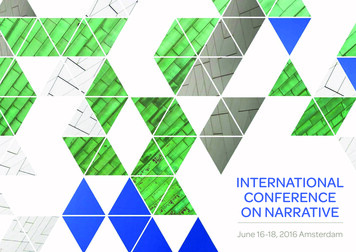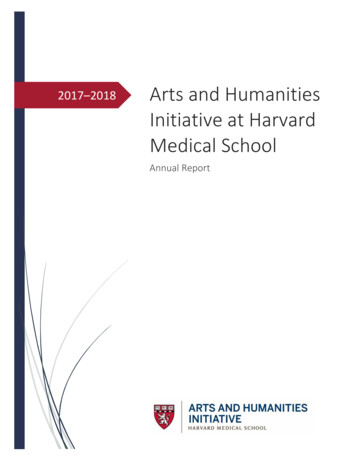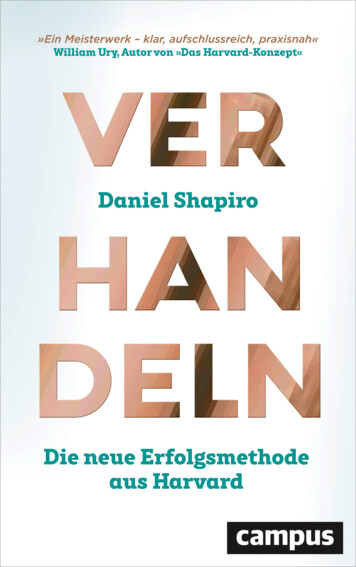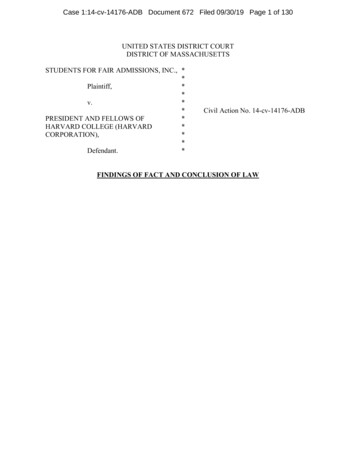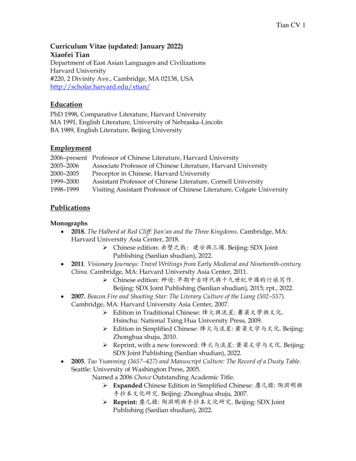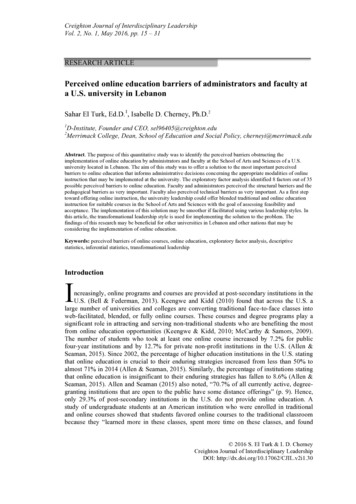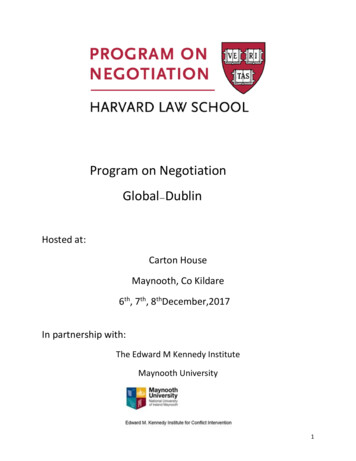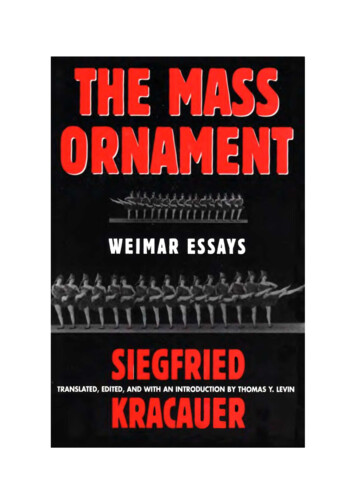
Transcription
Siegfried Kracauer w a s o n e of the twentieth century's most brilliant cultural critics, a b o l d a n d prolific scholar, a n d an incisive theorist of film. In this volumehis important e a r l y writings on m o d e r n society d u r i n g the W e i m a r Republicm a k e their l o n g - a w a i t e d a p p e a r a n c e in English.This b o o k is a celebration of the masses—their tastes, amusements, a n d everyd a y lives. Taking up the master themes of modernity, such as isolation a n da l i e n a t i o n , mass culture a n d u r b a n e x p e r i e n c e , a n d the relation between theg r o u p a n d the i n d i v i d u a l , Kracauer explores a k a l e i d o s c o p e of topics: shopp i n g a r c a d e s , the c i n e m a , bestsellers a n d their readers, p h o t o g r a p h y , d a n c e ,hotel lobbies, K a f k a , the Bible, a n d b o r e d o m . For Kracauer, the most revelat o r y facets of m o d e r n metropolitan life lie on the surface, in the e p h e m e r a l a n dthe m a r g i n a l . The Mass Ornament t o d a y remains a refreshing tribute to p o p u lar culture, a n d its impressively interdisciplinary essays continue to shed lightnot o n l y on Kracauer's later w o r k but also on the ideas of the Frankfurt S c h o o l ,the g e n e a l o g y of film theory a n d cultural studies, W e i m a r cultural politics, a n d ,not least, the exigencies of intellectual exile. This volume presents the full scopeof his gifts as o n e of the most w i d e - r a n g i n g a n d penetrating interpreters ofm o d e r n life." K n o w n to the English-language public for the books he w r o t e after he r e a c h e dA m e r i c a in 1 9 4 1 , most famously for From Caligari to Hitler, Siegfried Kracauer is best understood as a charter m e m b e r of that e x t r a o r d i n a r y constellation of W e i m a r - e r a intellectuals w h i c h has been d u b b e d retroactively (and misleadingly) the Frankfurt S c h o o l . This collection of Kracauer's e a r l y essays—likehis friends W a l t e r Benjamin a n d Theodor A d o r n o , he b e g a n as an essayistprovocateur on a w i d e variety of social a n d cultural themes—does m o r e thane x p l a i n the origins of the eminent film critic a n d theorist. It includes some ofhis most o r i g i n a l a n d i m p o r t a n t w r i t i n g . "-Susan SontagS I E G F R I E D K R A C A U E R ( 1 8 8 9 - 1 9 6 6 ) w a s the author of From Caligari toHitler, Theory of Film, a n d m a n y other w o r k s on historical, s o c i o l o g i c a l , a n dcultural topics. Thomas Y. Levin is Assistant Professor of G e r m a n at PrincetonUniversity.HARVARD UNIVERSITY PRESSC a m b r i d g e , MassachusettsLondon, EnglandCover design: Lisa ClarkCover photograph: "The Tiller Girls," from Fritz Giese,Girl-Kultur
Siegfried Kracauer, late 1920s
SIEGFRIEDKRACAUERTranslated, Edited, and with an Introduction byThomas Y. LevinHarvardUniversityC a m b r i d g e , MassachusettsLondon, EnglandPress
Copyright 1995 by the President and Fellows of Harvard CollegeAll rights reservedPrinted in the United States of AmericaThis book was originally published as Das Ornament der Masse: Essays,by Suhrkamp Verlag, copyright 1963 by Suhrkamp Verlag.LIBRARYOFCONGRESSCATALOGING - I N - P U B L I C A T I O NDATAKracauer, Siegfried, 1889-1966.[Ornament der Masse. English]The mass ornament: Weimar essays / Siegfried Kracauer ;translated, edited, and with an introduction by Thomas Y. Levin,p.cm.Originally published as: Das Ornament der Masse: Essays, bySuhrkarnp Verlag, cl963.Includes bibliographical references and index.ISBN 0-674-55162-1. — ISBN 0-674-55163-X (pbk.)1. Levin, Thomas Y. II. Title.AC35.K64613 1995081—dc2094-47397CIP
For Theodor W. Adorno
ContentsTranslator's NotexIntroduction, by Thomas Y. Levin1Lead-In: Natural GeometryLad and BullT w o PlanesAnalysis of a City Map333741External and Internal ObjectsPhotographyTravel and DanceThe Mass OrnamentOn Bestsellers and Their AudienceThe Biography as an Art Form of the New BourgeoisieRevolt of the Middle ClassesThose Who Wait47657589101107129ConstructionsThe Group as Bearer of IdeasThe Hotel Lobby143173PerspectivesThe Bible in German189Catholicism and Relativism203The Crisis of Science213 vii
C O N T E N T SGeorg Simmel225On the Writings of Walter Benjamin259Franz Kafka267The MoviesCalico-World281The Little Shopgirls Go to the Movies291Film 1928307Cult of Distraction323Fadeaway: Toward the Vanishing PointBoredom331Farewell to the Linden Arcade337Notes345Bibliographic Information391Credits396Index397
IllustrationsSiegfried Kracauer, late 1920sFrontispieceMax Beckmann, Editorial office of the Frankfurter Zeitung, 19247Siegfried Kracauer's journalist identification card, 193321Bullfight in the arena at Nimes, France32T h e quay of the old harbor in Marseilles, France, late 1920s36Marianne Breslauer, Untitled, Paris, 192940Sasha Stone, Untitled, after 193246Laszlo Moholy-Nagy, "Berlin Radio Tower," 192564Girls at a rehearsal, 192974Werner Mantz, Sinn Department Store, 192888Germaine Krull, Woman and car, mid-1920s100Erich Comeriner, "Berlin, FriedrichstraBe," ca. 1930106Sasha Stone, "Kaiser Wilhelm Memorial Church," ca. 1929128Martin Munkasci, "Spectators at a Sports Event," ca. 1933142Scene from Ihr dunkler Punkt, 1929172Herbert Schurmann, "Lattice between Panes of Glass," 1933188Georg Muche, "Photo Composition," 1921202Sasha Stone, Photographic telescope at the Einstein Tower, 1928212August Sander, Advertising photograph for a glass manufacturer, 1932224Umbo (Otto Umbehr), "The Uncanny Street, No. 1," 1928258Willy Otto Zielke, Pyramid, 1929266Aerial view of the U F A studios in Neubabelsberg, ca. 1930280August Sander, Cinema staff, 1929290Willy Otto Zielke, Agfa, early 1930s306Titania Palace Cinema, Berlin, 1928322Werner David Feist, "Alarm Clock," ca. 1929330l.lnden Arcade, 1930336 ix
Translator's NoteT h i s translation is based on the second edition of Das Ornament derMasse: Essays (Frankfurt: Suhrkamp Verlag, 1977), which, as the editorKarsten Witte explains in his afterword, is essentially identical to the firstedition that Kracauer himself supervised in 1963. Aside from the correction of typographical errors and bibliographic data, the only substantive change made in the later, posthumous edition was the reinsertion ofa number of passages that had figured in the original versions of the essayspublished in the Frankfurter Zeitung but that Kracauer had for somereason excised from the 1963 edition. T h e translation follows Witte'sphilological lead and reinstates all passages, titles, emphases, and textbreaks from the original publications, marking them as such in the notes.Indeed, as already suggested by the slightly modified subtitle WeimarEssays, the various editorial additions all attempt to compensate for theirreducible temporal and linguistic distance of the texts from their original historical and intellectual context. T h u s , the annotations serve notonly to articulate thorny or especially rich translative moments and toprovide bibliographic and filmographic data for cited works and passages,but also to elucidate the wide range of cultural references from theWeimar period that are embedded in Kracauer's prose. T h e constellationof photographs from the Weimar period is intended to have a similarlyevocative function. T h e decision to include them was motivated by acomment Kracauer made upon rediscovering the early essays that wouldeventually make up Das Ornament der Masse. In a letter to Adorno onOctober 1, 1950, conveying the news of his find, Kracauer expressed thewish that these Weimar texts be published in a book-length collection"which could include drawings" (cited in Marbacher Magazin 47 [1988]:110). T h e minimally intrusive location of the photographs between.
TRANSLATOR'SNOTErather than within, the individual essays is meant to signal that their function is more emblematic than illustrative. All notes, except where specified otherwise, have been added by the translator. "Reality is a construction": this oft-cited phrase from Kracauer's studyDie Angestellten is equally true for the reality of a translation project suchas this one. Among my many co-constructors, I would like to thank aboveall Lindsay Waters and Alison Kent of Harvard University Press for theirgenerous encouragement and heroic editorial patience; Miriam Hansen,who introduced me to Kracauer during my graduate work at Yale andencouraged me to undertake this translation; Karsten Witte for hisuntiring assistance and friendship at every stage in this project; EricRentschler and Evi and Walter Levin for their careful readings and comments on the entire volume; Jerry Zaslove and the Institute for theHumanities at Simon Fraser University for their magnanimous supportof translation reviews of a number of the essays by Michael Mundhenk;Ingrid Belke and the superb staff at the Deutsches Literaturarchiv inMarbach am Neckar for their help during my research in the Kracauerpapers over the years; the J. Paul Getty Foundation and the PrincetonUniversity Committee for Research in the Humanities for stipends thatsubsidized both research and production costs; and the German Academic Exchange Service ( D A A D ) , which sustained this project at variousstages from its beginning to its completion. Among the many friends,colleagues, and fellow Kracauer scholars who were generous with comments, suggestions, and critiques, I would like to express particular gratitude to Edward Dimendberg, David Frisby, Karsten Harries, AntonKaes, Thomas Keenan, Michael Kessler, Evonne Levy, Leyla Mayer,Klaus Michael, Inka Mulder-Bach, Gerhard Richter, D. N. Rodowick,Heide Schliipmann, Andreas Volk, and Judith Wechsler. Maria Ascher'smeticulous and astute editorial scrutiny has been a pleasure and an enormous help, not least in ridding the translation of residual teutonicisms inboth vocabulary and style. Although Kracauer's often poetic theoreticalprose presents a special challenge to the translator, any infelicities thatremain here are entirely my responsibility.
IntroductionThomas Y. LevinToday, access to truth is by way of the profane.—Siegfried Kracauer, " T h e Bible in German"Among the many refugees gathered in Marseilles in August 1940,hoping to flee the tightening grip of collaborationist France, were twoGerman Jewish cultural critics: Walter Benjamin and Siegfried Kracauer. These long-time friends had corresponded with each other formany years, worked on similar issues, published in many of the same1venues, and written about each other's work. Both were now hoping toreach N e w York, where they were awaited by friends and former colleagues at the Institute for Social Research—Theodor Adorno, MaxHorkheimer, Leo Lowenthal, Meyer Schapiro, Richard Krautheimer-—who had signed affidavits and arranged for their travel to, and employment in, the United States. Weeks went by during which the two metalmost every day. In late September, after Spain suddenly announcedthat it would no longer issue transit visas to people without passports,Benjamin attempted to cross the border illegally by way of a difficultmountain path through the Pyrenees. Carrying the same papers asKracauer, he was detained at the border and, in desperation, took hislife. Only days later Kracauer and his wife Lili attempted the same routeand were also forced to turn back, ending up in Perpignan. T h o u g hlikewise close to despair, they continued to wait; and in February 1941,1
I N T R O D U C T I O Nafter a few agonizing months, they were finally able to get across Spainto Lisbon, whence they embarked for America. Here, after eight hardyears of exile in France, the fifty-one-year-old immigrant and his wifehad to start over once again.Forced to learn yet another new language, Kracauer was nevertheless able to eke out a living in N e w York as a freelance writer,publishing articles in a wide range of journals (including the PublicOpinionQiuirlcrly, and the New York Times Book Review), as well as preparingcommissioned but largely unpublished "reports" for various government and research agencies such as the Experimental Division for ,U N E S C O , the Voice of America, and the Bureau of Applied SocialResearch at Columbia University.2Grants from the Rockefeller,Guggenheim, Chapelbrook, and Bollingen foundations also enabled himto pursue his own research, first as "special assistant" to Iris Barry,curator of the film library at N e w York's M u s e u m of Modern Art, andsubsequently as an independent scholar. T h o u g h he was often interrupted by other income-producing work, such as his obligations asconsultant to the Bollingen and the Old Dominion foundations, it wasduring these difficult last twenty-five years of his life that Kracauer alsoproduced the books which made his reputation in the English-speakingworld: his polemical history of Weimar cinema From Caligari to Hitler(Princeton University Press, 1947), his Theory of Film (Oxford U n i versity Press, 1960), and a meditation on the philosophy of historypublished posthumously as History:The Last Things before the Last(Oxford University Press, 1969).Kracauer was able to reach the N e w World, whereas Benjamin wasnot. Curiously, however, the opposite is true of their writings from theWeimar period. Unlike Benjamin's oeuvre, which is well known andincreasingly available in translation, Kracauer's successful emigration tothe Anglo-American realm effectively delayed the English-languagereception of the fascinating corpus of early writings which had built hisreputation as one of Weimar Germany's most incisive political andcultural critics. Indeed, Anglo-American readers generally know only2
I N T R O D U C T I O Nthe many works Kracauer produced in English during his exile in theUnited States and his "social biography" of Jacques Offenbach, which3he wrote and published during his years in France. T h e y remain largelyunaware of the nearly two thousand articles he published in the Frank4furter Zeitung during the 1920s and 1930s. T h i s disproportionate emphasis on Kracauer's exile production has certainly played a key role inthe reductive categorization of his work as "realist" film theory, a misperception in urgent need of revision. An exposure to his early writings,such as those collected here, will foster such a rereading, bringing tolight the epistemological foundations, the philosophy and theology ofhistory, the sociological sensibility, and the political motivations thatinform, in various and constantly shifting ways, Kracauer's turn tocinema and its relation to his other writings. Furthermore, by locatingKracauer's pioneering film criticism from the 1920s within the largerproject of his cultural criticism, these early texts reveal that Kracauerwas, as he himself once insisted, not exclusively "a film person butrather a cultural philosopher, or a sociologist, and a poet as w e l l . . . (Sofar as film is concerned, it was never anything b u t . . . a means of makingcertain sociological and philosophical points.)"5It is thus no accident that in the collection of his Weimar writingswhich Kracauer himself edited in 1963 under the title Das Ornament derMasse (The Mass Ornament), the few—albeit crucial—texts on photography and film are surrounded by allegorical meditations and scholarlyessays on everything from Kafka, Benjamin, Weber, Scheler, and Simmel to the Buber-Rosenzweig translation of the Bible, historical biography, boredom, urban arcades, and more. These texts present a verydifferent Kracauer, one formally, thematically, and epistemologicallyreminiscent of the Benjamin of EinbahnstraBe {One Way Street, 1928)and Illuminationen {Illuminations, 1961), the Bloch of Spuren (1930) andCrbschaft dieser Zeit {Heritage of Our Times, 1935), and the Adorno ofMinima Moralia (1951). It is here that one finds, for example, an explicitmticipation of Adorno and Horkheimer's "dialectic of enlightenment"llu-sis, but inflected in a way that leads to a refreshing rehabilitation ofpopular culture and "distraction" in defiance of polemically dismissivein counts of mass culture. In their relentless interdisciplinarity, and as an3
I N T R O D U C T I O Nexemplary articulation of aesthetics and politics, these early essays shedan important new light not only on Kracauer's own later work, but alsoon the Frankfurt School (and especially its analysis of mass culture), onthe genealogy of film theory and cultural studies, on Weimar culturalpolitics and, not least, on the exigencies of intellectual exile.If we consider their journalistic origins (twenty-one of the twentyfour texts reprinted in Das Ornament der Masse were first published inthe daily newspaper Die Frankfurter Zeitung), Kracauer's Weimar writings are astonishing not only in the freshness and relevance of theirarguments, but above all in their decidedly philosophical character. Forwhereas the contemporary daily newspaper with its editorial constraintsand inflexible production schedule is only rarely a forum for sustainedtheoretical writing, such substantive sociocritical reflection was thestaple of the continental tradition of feuilleton journalism for which theFrankfurter Zeitung was renowned. Founded in 1856 as a trade andfinance newspaper by the Jewish banker and politician Leopold Sonnemann, the Frankfurter Zeitung quickly became one of the leading andinternationally acclaimed organs of the liberal bourgeois press, highlyregarded in economics and business circles. Its politics were close tothose of the liberal Deutsche Demokratische Partei, with some leaningstoward the Social Democrats. Explicit in its support of the Weimarconstitutional democracy, it favored the signing of the Versailles treatyand advocated nationalization of major branches of the economy of thenew republic. Although it never had the circulation of any of the othercompeting bourgeois papers, all of which were located in Berlin, it wasa highly visible publication, appearing daily in no less than four editions(three local and one national), each with numerous special supplements.Once described by Joseph Roth as "a microcosm of Germany," theFrankfurter Zeitung complemented its political and economic coveragewith an equally prestigious feuilleton—somewhat equivalent to today'sarts and culture section—which was featured prominently on the lowerthird of the cover and subsequent pages in every issue. It was here,"below the line" (a reference to the graphic marker which served toseparate the section devoted to cultural criticism from the remainder ofthe paper), that Kracauer published the vast majority of his work.4
I N T R O D U C T I O NT h e feuilleton as a genre had existed since the nineteenth centuryas a site for belletristic excursions of all sorts, but it began to play animportant role in Germany only in the wake of World War I, at a momentwhen the inherited cultural vocabulary seemed particularly inadequate tothe reality of the nascent republic. Indeed, as evidenced in the prescientjournalistic writings of feuilleton editors such as Joseph Roth and Siegfried Kracauer, one could say that in the Weimar era the feuilleton tookon an avant-garde function as the locus of a concerted effort to articulatethe crisis of modernity. Its transformation from a belletrist forum into asite for diagnostic analyses of contemporary phenomena is perhaps bestexemplified in Kracauer's very popular dissection of the new employeeclass of white-collar workers, first published serially in the feuilleton ofthe Frankfurter Zeitung, and subsequently in book form as Die Angestellten.Through the combined efforts of the regular feuilleton authors,many of w h o m Kracauer himself engaged—including Alfons Paquet,Friedrich Sieburg, Wilhelm Hausenstein, Soma Morgenstern, Bernardvon Brentano, Theodor Adorno, Walter Benjamin, Ernst Bloch, andJoseph Roth—the Frankfurter Zeitung feuilleton assumed a new shape inresponse to the rapidly changing social and cultural character of modernity. Here, Kracauer and others examined the Weimar Republic in theway that, as Adorno recalled in an intellectual portrait of his friend, Kracauer had taught him to approach philosophy—that is, "as a kind of codedtext from which one could read the historical situation of the spirit[Geist], with the vague expectation that in doing so one could acquiresomething of truth itself."7It was Kracauer who, in a programmatic insight, perhaps bestcaptured the new orientation of the feuilleton: "We must rid ourselvesof the delusion that it is the major events which have the most decisiveinfluence on us. We are much more deeply and continuously influenced8by the tiny catastrophes that make up daily life." Besides presentingbook reviews, conference reports, and other analyses of the state ofintellectual and cultural life in the republic, the feuilleton was thus therealm of the quotidian—unemployment offices and arcades, travel experiences and dance troupes, bestsellers and boredom, neon-light displaysand mass sports events—which became the focus of philosophical5
I N T R O D U C T I O Ninand sociological analyses very much in the tradition of Kracauer'steacher Georg Simmel (about w h o m he wrote a book-length monograph9in the early 1920s). To explain this new cultural landscape, the feuilleton now practiced a sort of physiognomic essayistics, a minutedecoding of the surface phenomena of modernity as complex historicalciphers. T h e polemical stakes in Kracauer's deployment of such philosophical micrologies (Simmel called them Momentbilder, snapshots) maybe less evident today in light of the ubiquity of "thought-images"(Denkbilder, to use Benjamin's term for the genre), as popularized, for10example, by Roland Barthes' Mythologies. At the time, however, thefeuilleton of the Frankfurter Zeitung effectively provided Kracauer witha laboratory in which he and others could experiment with such newforms along the lines of the "material theory of knowledge" that he hadproposed in 1920 and whose theoretical contours he had articulated inhis1922 study Soziologie als11Wissenschaft (Sociology as Science).Kracauer joined the Frankfurter Zeitung as a salaried writer inAugust 1921, abandoning an unfulfilling career as a trained architect inorder to pursue, as a journalist, his double passion for sociology and philosophy. During the first years his assignments consisted mostly ofreports on local Frankfurt events and topics: lectures, conferences, architecture, city politics, and films, as well as short notices on new books(especially in philosophy, the social sciences, and architecture) and occasional essayistic pieces, many written under pseudonyms. Benno Reifenberg's appointment as head of the feuilleton staff in 1924 strengthenedKracauer's position at the paper: he became a full editor with his ownoffice, a promotion that allowed him to delegate much of his localreporting duties and to expand his writings on cinema into a regularcolumn, in which he effectively pioneered the genre of sociological filmcriticism. However, as Kracauer's feuilleton contributions became morepolemical and ideologically critical in the wake of political developmentsin the late 1920s, they were increasingly at odds with the new financialand political allegiances of the Frankfurter Zeitung. T h e economic crisisin the 1920s and structural transformations in the advertising market following World War I were having dire consequences for many newspapersin Weimar Germany, and the Frankfurter Zeitung was no exception. 6
I N T R O D U C T I O NMax Beckmann, Editorial office of the Frankfurter Zeitung; pencil sketch, 1924"Saved" from financial insolvency in 1929 by an infusion of launderedcapital, which, as later became clear, stemmed from the chemical conglomerate I. G. Farben, the paper subsequently began to manifest signsof editorial bankruptcy in its newfound, decidedly pro-industry orien12tation. This was dramatically evident in a series of politically motivatedpersonnel changes, especially among the altogether too-critical feuilletonstaff. Though Heinrich Simon remained in charge as chief editor, Reifenberg was replaced by a Swiss lawyer, Friedrich Traugott Gubler, andthe liberal editor of the Berlin bureau, Bernhard Guttmann, was replacedby the more cooperative and conservative Rudolf Kirchner, provokingthe bitter resignation of Bernard von Brentano, the Frankfurter Zeitung\cultural correspondent in Berlin.T h e change in the paper's ownership had important consequencesfor Kracauer as well. Instead of becoming Reifenberg's successor, as 7
I N T R O D U C T I O Nexpected, he was sent to run the Berlin feuilleton, a lateral move that wasless a promotion than the first in a series of indignities whose final (andultimately successful) aim was to eliminate a highly outspoken, wellknown, and excessively left-wing editor. According to Kracauer's ownaccount in his autobiographical novel Georg,during the Berlin years thepaper's new, increasingly conformist regime repeatedly rejected orseverely cut his articles, drastically reduced his pay without any reductionof responsibilities, and even threatened to "sell" him to the enemy, negotiating behind his back in 1931 for him to be engaged by the state filmconglomerate U F A , which could thereby silence one of its most bitingcritics. In the wake of the Reichstag fire in early 1933, what had beenlatent became explicit: after eleven years as an editor at the FrankfurterZeitung, Kracauer—who had fled to France in the meantime and hadhopes of becoming the Paris correspondent—was summarily fired, thepaper obviously counting on the fact that in Nazi Germany an emigratedJew would have no legal recourse. When Kracauer nevertheless sued forseverance pay through a Berlin lawyer, the Frankfurter Zeitung cited asgrounds for his dismissal the fact that he had published a text in LeopoldSchwarzschild's unacceptably leftist journal Das neue Tagebuch withoutthe paper's prior approval.By the early 1930s, Kracauer had become a highly respected voicein the Weimar public sphere and might well have capitalized on hisrenown in order to make a career as a freelance writer. In light of this fact,it is important to understand what might have motivated his decision tostay at the Frankfurter Zeitung despite its increasingly unacceptable editorial politics and the rapidly degenerating work environment. It couldhardly have been the financial security of being a salaried editor (whichultimately turned out to be short-lived) that kept Kracauer fromaccepting one of the repeated offers to write for a more ideologically sympathetic but less widely read paper such as the Weltbuhne. Rather, Kracauer's decision to stay with the increasingly conservative FrankfurterZeitungwas surely informed by strategic political considerations. A moveto another forum would have dramatically changed the makeup of Kracauer's reading public just when—given the growing political influence ofthe right, and of the National Socialists in particular—it was more 8
I N T R O D U C T I O Ncrucial than ever for him to maintain his contact with the bourgeois classthat constituted the majority of the Frankfurter Zeitung's readership.T h u s , instead of writing for a more "engaged," left-wing publicationduring the last years of the Weimar Republic, Kracauer deliberatelychanneled his polemical editorial energies into the Frankfurter Zeitungfeuilleton, publishing a series of critical exposes of "conservativerevolutionary" developments, such as his 1931 analyses "Bestsellers andTheir Audience" and "Revolt of the Middle Classes," the latter an ideological unmasking of the conservative journal Die Tat.T h e political imperatives and sense of responsibility that informedKracauer's self-conception as an engaged intellectual during the crucialfinal years of the Weimar Republic are articulated quite clearly in hisessay "Uber den Schriftsteller" ("On the Writer"), which also datesfrom 1931. T h e task of the journalist, Kracauer writes, has always been14to "attack current conditions in a manner that will change t h e m . " H o w ever, in the wake of recent pressures (state censorship, the resulting selfcensorship, and the increasingly dire financial circumstances of an evermore conservative bourgeois press), newspapers might no longer offerthe best site for this sort of critical social practice. Instead, as Kracauerobserves (recasting the then-prevalent juxtaposition of the politicallyconcerned journalist and the more indulgently autonomous "writer"),15the traditional responsibility of the journalist has begun to fall more andmore to "a new type of writer." According to Kracauer, himself theauthor of the quite popular anonymously published novel Ginster (1928),there is a new breed of writers who, "instead of being contemplative, arepolitical; instead of seeking the universal beyond the particular, they findit in the very workings of the particular; instead of pursuing developments, they seek ruptures." Although he resisted doing so until he hadno other choice, Kracauer himself ultimately opted for what he hadalready foreseen in 1931 as the inevitable consequence of this logic: "todo justice to his duty as a journalist [by] joining the ranks of the writers."With his dismissal from the Frankfurter Zeitungand the beginning of hislife-long exile, Kracauer's journalistic voice had to seek new sites andforms of expression. Nevertheless, the book-length studies that becameKracauer's primary mode of production during the following decades 9
I N T R O D U C T I O Nshould be seen, despite their differences in scope, tone, and focus, as continuing to stand in some sort of relation to the project of his earlier political and cultural criticism.16Kracauer's commitment to journalism as a vehicle for engaging thepublic sphere was
comment Kracauer made upon rediscovering the early essays that would eventually make up Das Ornament der Masse. In a letter to Adorno on October 1, 1950, conveying the news of his find, Kracauer expressed the wish that these Weimar texts be published in a book-length collection "which could
